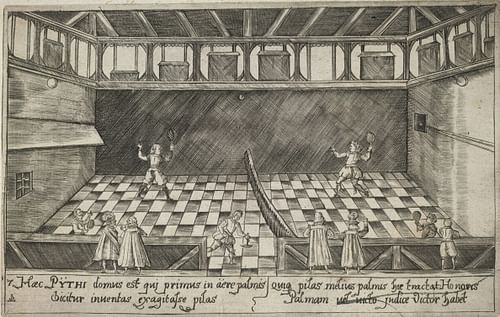
Tennis: Origin and evolution of the sport

A game of real tennis, Raquet sport
From the royal courts in medieval France and Britain to Roland Garros and Wimbledon, and from King Henry VIII to Pete Sampras and Roger Federer, the amazing sport of tennis has come a long way while maintaining its tradition and charm.
Origins
The earliest origins of the sport are still disputed, with a set of historians believing that the ancient Greeks, Romans and Egyptians were the first to play the game that would go on to evolve as tennis. Descriptions to suggest the existence such a sport have been discovered, and there have been pictures which depict a game where a ball was stroked above a net.
The theorists believe that “tennis” derives its name from Tinnis, the Egyptian town on the banks of the Nile, and “racquet” is derived from “rahat”, an Arabic word which means palm of the hand.
Records show that in the fifth century, villagers in Tuscany, Italy would play a sport on the streets which involved striking the ball up and down with their hands.
However, most historians believe that the earliest origin of the sport was down to French monks in the 11th and 12th century, who would play with a crude handball against the walls of their monasteries, or over a rope which was strung across their courtyards. This sport was referred to as “jeu de paume”, which translates as “game of the hand”. The word “tennis” is believed to have originated from the French word “tenez” which loosely means “take this”, which would be told by the player to the other while serving.
Growth in popularity
The game grew in popularity, and soon courtyard playing areas began to be converted into indoor courts, where the ball was played off the walls. Playing with bare hands was found to be uncomfortable, which led to the use of gloves, which further evolved into a webbing with a handle attached (similar to a racquet). The ball used was either wool or cork wrapped in cloth or leather with string.
The monks passed on the game to the nobility in the 13th century, and its increasing popularity initially saw opposition when the Pope and Louis IV attempted (unsuccessfully) to ban it. It later spread to Britain, and Henry VII and Henry VIII actively played the game and built many courts. The game, now enjoying the patronage of the royals, was referred to as royal tennis or real tennis.
Henry VIII famously built the court at Royal Palace of Hampton Court in 1625, which is still used for modern competition. It is a narrow, indoor court where ball is played off the walls. The walls include many openings and oddly angled surfaces which could be used for game strategy. The net is 3 feet high in the middle, and 5 feet high at the ends.
Advent of rubber balls and outdoor game
The game saw its popularity dwindle to almost zero in the 18th century after the French Revolution. But in the 1850s, after Charles Goodyear invented the vulcanization process for rubber, players started experimenting with bouncier rubber balls on grass, which was played outdoors. Since the outdoor game was different to the indoor game which was played off the wall, a new set of rules was formulated for it.